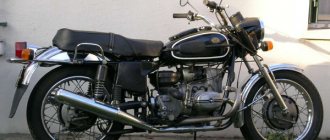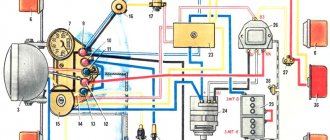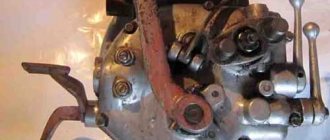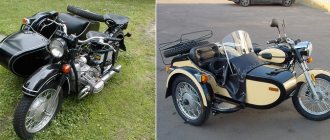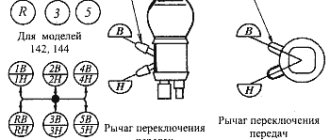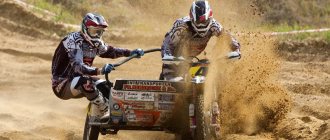"Ural"
- Soviet and Russian heavy motorcycle, produced at the Irbit motorcycle plant (Sverdlovsk region, Irbit). In the vast majority of cases it is used with a stroller. Motorcycle models are available both with and without sidecar wheel drive. The stroller wheel drive is switchable, non-differential. “Ural” is a further development of the M-72 motorcycle, a copy of the German BMW R71.
The following models were produced in 2013:
- with a stroller: “Ural-T”, “Tourist”, “Patrol 2WD”, “Gear-UP”, “Retro” [1] ;
- singles (without a stroller): “Retro Solo” and “Solo sT” [1].
These motorcycles are equipped with a four-stroke boxer two-cylinder engine with a volume of 750 cm³ and a power of 41 hp. With. (30 kW), 4-speed gearbox with reverse gear and cardan drive of the rear wheel [2].
List of models [edit | edit code]
Road motorcycles [ edit | edit code]
- IMZ M-72 (1940-1961) - the first motorcycle of the Irbit plant, a copy of the BMW R71, was modernized throughout its production, the latest model even received a short-lever fork and aluminum wheel hubs;
- IMZ M-52 (single) (1950-1957) - a model with the chassis of the M-72 and a 500 cm³ engine. Only a limited edition of 678 motorcycles was produced;
- IMZ M-61 (1957-1963) - a transitional model with the chassis from the M-72 and a new engine (650 cm³), the travel of the front fork and rear suspension has been increased. The front fork has been changed. The crew section has been lightened;
- “Ural” M-62 (1961-1965) - new gearbox, increased suspension travel, automatic ignition timing introduced, camshaft cam profile changed to reduce wear. The steering has been changed (chain throttle and duralumin clutch and brake levers);
- “Ural-2” M-63 (1963-1971) - a frame with a pendulum suspension of the rear wheel on spring-hydraulic shock absorbers (later a similar suspension was introduced on the sidecar wheel), ground clearance was significantly increased due to the introduction of a new exhaust system.
- “Ural-3” M-66 (1971-1975) - the engine was significantly modernized, the power increased to 32 hp. With. Engine durability has been increased due to full-flow oil purification and the use of a new crankshaft design. The motorcycle has direction indicators and new lights;
- "Ural" M-67 (1973-1976) - twelve-volt electrical equipment was used. The design of the motorcycle frame has been changed;
- “Ural” M-67-36 (1976-1984) - due to changes in the design of the cylinder heads, the use of K-301G carburetors with an increased diffuser diameter and an increase in the diameter of the exhaust system, the engine power was increased from 23.5 to 26.5 kW. (36 hp). The right turn signal on the motorcycle itself has been removed.
- “Ural” IMZ-8.103-30 (1985-1986 [ source not specified 2336 days
]) - the frame and rear suspension, optics, electrical equipment were modernized, a brake was installed on the sidecar wheel, instead of two mufflers, one was installed on the right side; - “Ural” IMZ-8.103-10 (1987-1994) - differed from the previous model by the presence of reverse gear, slightly lighter weight, noise and fuel consumption;
- “Ural” IMZ-8.103-40 Tourist - equipped with a lever front fork;
- “Ural” IMZ-8.123 Solo - a single unit based on the IMZ-8.103-10, engine power 40 hp. pp., 18-inch wheels;
- "Ural" IMZ-8.1037 GEAR-UP;
- "Ural" IMZ-8.1243 Voyage;
- "Ural" IMZ-8.1024 Cobra;
- “Ural” IMZ-8.1238 Wolf (1999-2011) - a motorcycle in the chopper style [3] [4] ;
- "Ural" IMZ-8.1036 Retro
Sports motorcycles [ edit | edit code]
- M-35;
- M-52S for road racing;
- M-52K for cross-country competitions;
- M-61K for cross-country competitions;
- M-62K for cross-country competitions;
- M-75M;
- M-76;
- M-77 for road racing.
- M-80;
- K-1000 for cross-country competitions;
- “Cross” IMZ-8-201 for cross-country competitions.
Motorcycle control mechanisms Ural M 62
The control mechanisms of the Ural M 62 motorcycles are divided into hand and foot.
The clutch and brake levers of the front wheel of the M-61 motorcycle are located on the handlebars with the ends outward.
The carburetor throttle control knob is a single cable coil type. The cable in the handle is wound onto the drum and, through a special adapter, transmits force to the throttle valve control cables of each carburetor.
The M62 motorcycle uses a two-cable throttle control. A chain is wound onto the drum, rigidly connected to a slider, to which the throttle valve control cables are attached.
There is no ignition timing lever on the M62 motorcycle, since it is equipped with an automatic ignition timing device.
The brake control mechanisms of the Ural M 61 and M 62 motorcycles are identical in design.
The brake pads of the hand and foot brakes are interchangeable.
Each pair of pads is tightened by two springs.
The expanding fists of the hand and foot brakes have small slots on their outer ends on which the levers are secured.
The hand brake lever is connected to a cable, and the foot brake lever is connected to a control rod.
The hand brake is adjusted using the adjusting screw on the brake drum cover.
The foot brake is adjusted using the adjusting wing nut at the front end of the brake rod.
Return to contents — ↑
Technical characteristics of modern models [edit | edit code]
Tourist, Tourist 2WD, Gear-UP, Troika Lux [edit | edit code]
| Tourist | Tourist-2WD | Gear-UP | Troika Lux | |
| Model: | IMZ-8.1037 Tourist | IMZ-8.1037 Tourist-2WD | IMZ-8.1037 Gear-UP | IMZ-8.1037 Troika Lux |
| Dimensions L×W×H, mm: | 2580×1700×1100 | 2580×1700×780 | 2580×1700×1100 | |
| Ground clearance, mm: | 125 | |||
| Dry weight, kg: | 350 | |||
| Total weight, kg: | up | |||
| Fuel tank, l: | 19 | |||
| Maximum speed, km/h: | 105 | |||
| Fuel consumption in the city, l/100 km: | 6-7 | |||
| Fuel consumption on the highway, l/100 km: | 4-5 | |||
| Engine: | 745 cm³, 42 l. p., 4-stroke, 2 cylinders, opposed OHV | |||
| Launch: | electric starter and kickstarter | |||
| Electrical system: | 12 V, generator 500 W | |||
| Ignition system: | contact | |||
| Checkpoint: | 4-speed, with reverse | |||
| Main gear: | gimbal | |||
| Gear ratios: [15] | I - 3.6; II - 2.62; III - 1.61; IV - 1.3; Rear: 4.2 | |||
| Main gear ratio: | 4,62 | |||
| Tires: | 4.00x - 19″ | |||
| Wheels: | knitted, painted, 19″ | spoked, chrome-plated, 19″ | knitted, painted, 19″ | spoked, chrome-plated, 19″ |
| Brakes: | front - hydraulic, disc; rear - drums | |||
| Suspension: | front - lever with spring-hydraulic shock absorbers; rear - pendulum with spring-hydraulic shock absorbers, adjustable for load | front - telescopic; rear - pendulum with spring-hydraulic shock absorbers, adjustable for load | ||
| Seat: | separate, double adjustable | solid | separate, double adjustable | solid |
| The package includes additional equipment: | Painted stroller wheel rack, driver's mudguards, passenger handles, parking brake | Chrome-plated rack for the stroller wheel, searchlight, driver's mudguards, stroller glass, shovel, canister, chrome-plated driver's protective bar, chrome-plated stroller protective bar | Stroller wheel rack, searchlight, shovel, canister, driver's mudguards, passenger handles, parking brake, driver's protective bar, stroller's protective bar | Chrome-plated luggage rack on the stroller wheel, chrome-plated passenger handles, velor upholstery of the stroller, leather passenger seat in the stroller, stroller glass, parking brake, driver's roll bar |
Retro, Retro-Solo, Wolf, Solo-sT [ edit | edit code]
| Retro | Retro Solo | Wolf | Solo-sT | |
| Model: | RETRO | RETRO SOLO | WOLF | Solo-sT |
| Dimensions L×W×H, mm: | 2224×1630×1020 | 2224×840×1060 | 2530×850×1300 | n/a |
| Ground clearance, mm: | 140 | 115 | 125 | |
| Dry weight, kg: | 343 | 220 | 260 | 198 |
| Total weight, kg: | 610 | 400 | 430 | n/a |
| Fuel tank, l: | 19 | |||
| Maximum speed, km/h: | 120 | 150 | ||
| Fuel consumption in the city, l/100 km: | 6-7 | 5-6 | ||
| Fuel consumption on the highway, l/100 km: | 4-5 | |||
| Engine: | 745 cm³, 42 l. p., 4-stroke, 2 cylinders, opposed OHV | |||
| Launch: | electric starter and kickstarter | |||
| Electrical system: | 12 V, generator 500 W | |||
| Ignition system: | microprocessor | |||
| Checkpoint: | 4-speed, with reverse | |||
| Main gear: | gimbal | |||
| Gear ratios: [15] | I - 3.6; II - 2.28; III - 1.56; IV - 1.19; Rear: 4.36 | |||
| Main gear ratio: | 4,62 | 3,89 | ||
| Tires: | 110/90-18″ | front 90/90-18″ rear 130/90-16″ | front 3.50-18″ rear 4.00-18″ | |
| Wheels: | spoked, chrome-plated, 18″ | spoked, chrome-plated, 18″ | spoked, chrome plated | spoked, chrome-plated, 18″ |
| Brakes: | front - hydraulic, disc; rear - drums | front - hydraulic, disc; rear - hydraulic, disc | front - hydraulic, disc; rear - hydraulic, disc | |
| Suspension: | front - telescopic; rear - pendulum with spring-hydraulic shock absorbers, adjustable for load | front - telescopic; rear - pendulum with spring-hydraulic shock absorbers, adjustable for load | ||
| Seat: | separate, double adjustable | separate, double adjustable | separate | separate |
| The package includes additional equipment: | Velor upholstery of the stroller, leather passenger seat in the stroller, stroller glass, parking brake, driver's roll bar | Driver safety bars | ||
the difference between the Dnipro box and the Uralyacha...
Peoples, that’s the subject. I've heard a lot that the Dnieper river will be better. But what? And what is this mysterious (for me) semi-automatic on the Dnieper?
Semi-automatic like in Java or Yupaca.
They say that neutral is better caught. This is true?
This is probably what you meant by the shift disk. Otherwise a person will look for a round dog with guides there
How about putting a starter in the Dnieper? Whether it is installed or not.
for Kangaroo
: So you put it on the Ural, and not just on the Dnieper (the gearbox doesn’t matter here), you pull out the starter, which rotates counterclockwise, cut the teeth on the flywheel (or take the Voyazhev flywheel, it already has teeth), make a hole in the crankcase (under the flywheel engagement by the starter) you weld the fasteners of this starter with argon, muddy up the wiring, put on the
RED BUTTON
(preferably taken from
the nuclear suitcase
), take the battery for help, and adjust everything. yeah, sorry about that.
[Edited 9/23/2003 Kmfbs]
:))))))))))))) and the missiles are probably aimed at the Yamahamoto, Suzukimoto, Hondamoto and HD factories. :)))))))))))
Kmfbs:—-na vse krome HD, milosti prosem :-))
for kpect
: We talk about his family and cormorants.
a bolshe drygoy xoroshey texniki nety krome Harley Davison
for yura_Y2K
: Factory Harley is a decent piece of crap (it’s not clear why you should pay that kind of money.)
for Kmfbs
: situYovina:
my brother installed the Dnipryachya checkpoint in the Urals. As a result, for the second time, the spline on the clutch disc is worn out ONLY ON THE ONE WHICH IS CLOSER TO THE TRANSMISSION. The clutch is assembled correctly.
what's wrong? It feels like the (primary) shaft only clings to one disc. Could this be possible?
Normally, the Ural box 8.103 is disassembled and assembled. The main thing is that during disassembly the shafts do not fall out and the adjusting washers do not fly off, otherwise it would be a hassle to find them around the garage and determine where they were. And when assembling, you just need to act carefully and make sure that the edges of the seals do not curl up. Well, you also need to cock the kick spring, but with two people there’s no question at all, and even one can get the hang of it.
There are real problems with neutral in the Urals. With the engine running, it is almost impossible to find neutral. When I opened the box, I realized that the problem was the unfortunate trajectory of the shift forks. There are two shift forks, first-second and third-fourth. The forks have two end points of travel: first gear and second, and third and fourth. The shift foot stop is adjusted so that the stroke of the shift shaft is such that the forks are thrown from one point to another and the fixation ball falls into the hole. And the neutral is made in the middle of the stroke of the 1-2 gear shift fork, and when you press a little harder on the shift foot, the fork simply flies past the neutral from one end point to another because the ball does not stay in the hole even with high applied force.
I suspect that this was done to make it easier to switch from first to second immediately, rather than through neutral. Like you push the lever all the way and you go straight from first to second, and you push slightly so that the ball hits the hole and locks neutral, but doesn’t go any further and you’ll be in neutral. The idea may have been good, but the execution was poor.
Total information
Motorcycle type: with sidecar. Wheelbase, mm – 1430. Ground clearance, mm – 130. Track, mm – 1100
Dimensions, mm: – length – 2420; – width – 1650.
Height (by ignition key) – 1000
Motorcycle weight, kg: – dry – 335; – worker – 380.
Fuel consumption on the highway, l/100 km – 7. Fuel reserve on the highway, km – 310. Highest speed, km/h – 85.
Capacity (oil), l: – engine crankcase – 2.0; – gearbox housing – 0.8; – reverse gear housing – 0.150; – air purifier – 0.2.
Fuel tank capacity, l – 22.
Transmission
On the M 61 and M 62 a clutch is installed, similar in design to the K 750 clutch, but the K 750 clutch is adjusted by one adjusting screw screwed into the clutch release lever, and the M 61 and M 62 clutches by two screws: an adjusting screw in the release lever and a shell stop screw cable screwed into the crankcase bracket.
Cardan and final drive diagram.
The power transmission gearbox of the Ural M 61 and M 62 motorcycles is the same in design as the M 72. True, there is not much difference, the M 62 differs from the M 61 only in the design of the shift couplings, the secondary shaft and its gears.
The cardan transmission is identical in design to the K750. The rear gears of the M 61, M 62 and K 750 are the same, with the exception of the crankcase covers: for the M 61 and M 62 motorcycles, the crankcase cover is made integral with the right suspension bracket, and the cover has an oil filler hole.
Return to contents — ↑
Engine
Engine type – four-stroke two-cylinder. Brand – M-72M. Cylinder diameter, mm – 78. Piston stroke, mm – 78. Working volume, cm³ – 746. Compression ratio – 5.5 ± 0.2. Maximum power, l. With. – 22. Maximum torque, kg m – 4.0. The block head material is aluminum alloy. Head gasket – asbestos metal 0.6 mm. The piston material is aluminum alloy.
Valve distribution phases (according to the angle of rotation of the crank), degrees: – beginning of intake to c. m.t. – 76; – end of inlet after n. m.t. – 92; – beginning of release BC m.t. – 116; – end of release after c. m.t. – 52.
Carburetor – Two K-37.
Messages [21 to 38 of 38]
21↑ Reply from sanekz 04/18/2014 22:33:17
Re: Installation of the Dnieper checkpoint in the Urals.
22↑ Reply from PATRIOT 04/20/2014 12:26:25
Re: Installation of the Dnieper checkpoint in the Urals.
Re: Installation of the Dnieper checkpoint in the Urals.
Well, you’ll still have to buy a Dnieper cross. I do not have it.
Are the crosspieces different? Or did I misunderstand something?
24↑ Reply from PATRIOT 04/20/2014 20:23:11
Re: Installation of the Dnieper checkpoint in the Urals.
Yes, the crosspieces are the same. GUK needs the Dnieper.
25↑ Reply from sanekz 04/20/2014 21:03:44
Re: Installation of the Dnieper checkpoint in the Urals.
find and install
26↑ Reply from PATRIOT 04/28/2014 01:48:24
Re: Installation of the Dnieper checkpoint in the Urals.
27↑ Reply from mexanik62 04/28/2014 07:49:06
Re: Installation of the Dnieper checkpoint in the Urals.
It is necessary to place a patch of the required thickness. There shouldn't be any play.
Edited by mexanik62 (04/28/2014 07:50:22)
28↑ Reply from PATRIOT 04/28/2014 11:37:37
Re: Installation of the Dnieper checkpoint in the Urals.
It is necessary to place a patch of the required thickness. There shouldn't be any play.
yes I already finished it yesterday
I'll cut it out of a tin can...
29↑ Reply from SS-man 04/28/2014 12:36:40
Re: Installation of the Dnieper checkpoint in the Urals.
It is necessary to place a patch of the required thickness. There shouldn't be any play.
yes I already finished it yesterday
I'll cut it out of a tin can...
better from a beer can
30↑ Reply from BETERR 04/28/2014 13:20:35
Re: Installation of the Dnieper checkpoint in the Urals.
Having previously emptied it.
31↑ Reply from drakone 04/28/2014 13:49:46
Re: Installation of the Dnieper checkpoint in the Urals.
and it’s healthier to dump it on the floor
32↑ Reply from Roma 04/28/2014 13:53:28
Re: Installation of the Dnieper checkpoint in the Urals.
Exactly! Or better yet, in the sink!
33↑ Reply from BETERR 04/28/2014 15:50:08
Re: Installation of the Dnieper checkpoint in the Urals.
Well, it’s whoever wants it. It’s possible, but I wouldn’t do it, why would something good go to waste?
34↑ Reply from drakone 04/28/2014 15:56:20
How to change gears on a motorcycle correctly
All movements you make with the pedals must be smooth so as not to damage the transmission.
When changing gears, change one speed at a time. It is not advisable to jump.
To understand how to change gears on a motorcycle, you need to carefully study the controls. There are motorcycles with manual transmission and semi-automatic.
Gear shifting methods
Method one
Motorcycles with manual transmission. All actions in this case occur in the following sequence. Pick up speed. Take off the gas. Engage the clutch. Press the gear shift pedal. Release the clutch, then the shift pedal and add gas.
To start the motorcycle, place it in neutral. After this, remove the gas and squeeze the clutch, at the same time turning on first gear. Taking your foot off the gear pedal, apply gas and release the clutch. Now add gas.
To upshift, you need to lift the gas, engage the clutch and press the gearshift pedal. After this, release the clutch, release the shift pedal and add gas.
To downshift, you need to remove the gas and engage the clutch. After this, sharply add gas, and when the speed begins to drop, press the gearshift pedal. Release the clutch and shift pedal and add gas. Once the motorcycle has stopped, be sure to put it in neutral.
Method two
Motorcycles with semi-automatic transmission. On these motorcycles, gear shifting is easier. Take off the gas and change gears. The clutch and gearbox are connected here.
Before starting the engine, place your bike in neutral. In order to engage first gear, you need to remove the gas and press the gear lever down. To increase the gear, you need to remove the gas and lift the gear lever up. To downshift, on the contrary, you need to apply gas and immediately remove your hand from the gas. When the speed starts to drop, change the speed and add gas. Now you know how to change gears on a motorcycle.
Read more: Engine resource reviews
